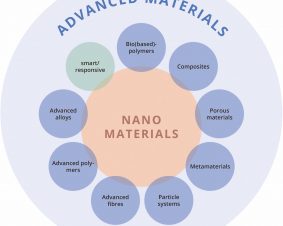 >
Spotlight August 2020: The nanoGRAVUR Grouping approach
>
Spotlight August 2020: The nanoGRAVUR Grouping approach
In August, we would like to present a paper of the German BMBF project nanoGRAVUR. nanoGRAVUR dealt from 2015-2018 with the grouping of nanostructured materials with regard to occupational safety, consumer and environmental protection and risk mitigation. The approach is now described by the project partners in this paper.
Due to the variety of synthetic nanomaterials and the numerous modifications (differences in size, shape, chemical composition and surface functionalization), the effort required to investigate effects and behaviour within the framework of regulatory requirements is enormous. Given the variability of possible effects, it is almost impossible to examine the potential risk for each nanomaterial on a case-by-case basis. Grouping or analogy now aims to allow a reliable prediction of hazards from nanomaterials of a group without additional testing by identifying certain properties or parameters.
For each of the three different areas of occupational, consumer and environmental safety, different groups may emerge, but they are based on a harmonised set of material properties with specific analytical methods, descriptors and areas. Proof of concept is provided in this publication by quantitative data on 34 case studies.
Original Publication:
Wohlleben, W, Hellack, B, Nickel, C, Herrchen, M, Hund-Rinke, K, Kettler, K, Riebeling, C, Haase, A, Funk, B, Kühnel, D, Göhler, D, Stintz, M, Schumacher, C, Wiemann, M, Keller, J, Landsiedel, R, Broßell, D, Pitzko, S, Kuhlbusch,T (2019), The nanoGRAVUR framework to group (nano)materials for their occupational, consumer, environmental risks based on a harmonized set of material properties, applied to 34 case studies. DOI 10.1039/c9nr03306h

Weitere Spotlights
Spotlight June 2022: From small to clever – What does the future hold for the safety and sustainability of advanced materials?
The smallest particles in materials research, nanoparticles, have occupied us intensively for more than 20 years to elucidate and further investigate their safety for humans and the environment. Now, however, the development is going from “small = nano” to “clever = advanced”, as discussed in a contribution by international scientists. Thereby, it is a great […]
Read moreSpotlight April 2022: A new risk assessment of nanomaterials in 3D printing is needed
The use of nanomaterials in 3D printing has great potential. Due to the properties of nanoscale materials, many requirements can be implemented in 3D printing. However, these unique properties based on the size of the particles also lead to the need for new risk assessments. This is because if the nanoparticles are released in the […]
Read moreSpotlight September: A methodology for the automatic evaluation of data quality and completeness of nanomaterials for risk assessment purposes
This paper describes a method for automatically assessing the quality and completeness of nanosafety data for the purpose of risk assessment. Steps to develop the methodology for assessing data completeness and the methodology for assessing quality are presented. The methodology is tailored to physicochemical and hazard (meta) data, but can also be configured with appropriate […]
Read moreSpotlight July 2021: The Path to Digital Material Research – It is never too late to start
Machine Learning, Artificial Intelligence, Big Data…. Have you read these words lately? No, these are not just buzzwords. The digitalisation of science is an evolving topic that is gaining importance with each passing day. That is why this month we would like to introduce you to the article “Digital Transformation in Materials Science: A Paradigm […]
Read more


